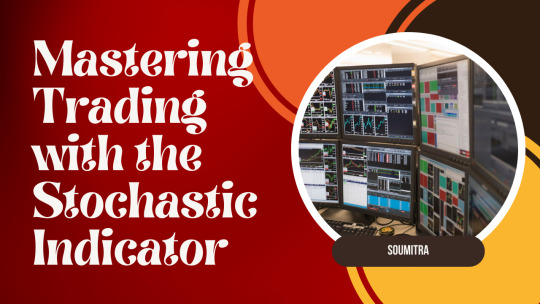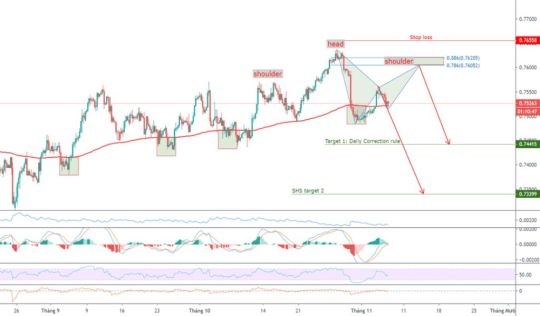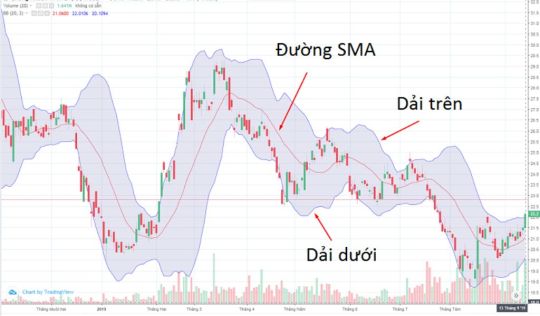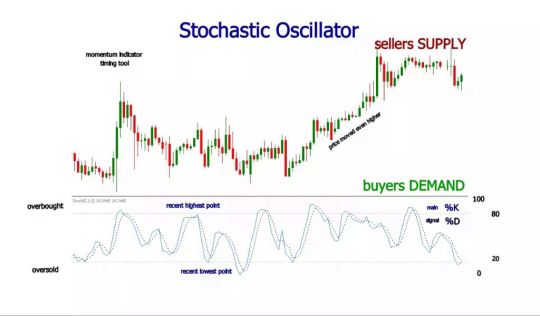#Stochastic Oscillator
Text
Mastering Trading with the Stochastic Indicator: A Comprehensive Guide
Introduction Stochastic
In the realm of financial markets, successful trading requires a deep understanding of various technical indicators. Among these tools, the Stochastic Oscillator stands out as a powerful tool for identifying potential trend reversals and overbought or oversold conditions in the market.
In this comprehensive guide, we will delve into the intricacies of the Stochastics…

View On WordPress
#Bearish Divergence#Bullish and bearish divergences#Bullish Divergence#Crossover Strategy#Momentum Indicators#Overbought and oversold conditions#Overbought Oversold#Risk Management#Risk management in trading#Stochastic#Stochastic crossover strategy#Stochastic indicator strategies#Stochastic Oscillator#Stochastic trend confirmation#technical analysis#Trading Strategies#Trading with Stochastics#Trend confirmation
0 notes
Text
Here Is A List Of The Most Common Trading Indicators
In trading, an indicator is a statistical measure of market conditions used to forecast price changes.
These are some of the most commonly used trading indicators, which are typically available on trading platforms like KuCoin:
Simple Moving Average (SMA): An average of the price over a certain number of periods (like days or hours). The formula for SMA is (A1+A2+A3…+An)/n, where A is the asset…

View On WordPress
#ATR#Average True Range#Bollinger Bands#crypto trading#EMA#Exponential Moving Average#Fibonacci Retracement#MACD#Moving Average Convergence Divergence#Relative Strength Index#RSI#Simple Moving Average#SMA#Stochastic Oscillator#trading indicators#Volume Weighted Average Price#VWAP
1 note
·
View note
Text
Zero Lag In and Out Forex Trading Strategy
Zero Lag In and Out Forex Trading Strategy
Using the Zero Lag In and Out Forex Trading Strategy can be a very effective method of making a profit from the market. It has been got to be tested with a number of different percentages, time intervals, and currency pairs.
MACD
Using the MACD is a good way to reduce risk and make a profit. However, you can end up losing money if you rely too heavily on the indicator.
The MACD is a signal…

View On WordPress
0 notes
Text
The Different Types of Technical Analysis in Forex
The Different Types of Technical Analysis in Forex
Forex traders have various methods for analyzing prices. One amongst the most popular types of analysis is technical analysis. This process involves the use of indicators and can help a trader make good decisions. Indicators can make forex trading a simpler process by providing easy-to-read signals. While the debate over technical versus fundamental analysis is ongoing, many traders opt for a…

View On WordPress
0 notes
Text
دليل شامل على مؤشر Stochastic Oscillator: كيفية استخدامه وفهمه بشكل صحيح
مؤشر Stochastic Oscillator هو مؤشر زخم يستخدم في التحليل الفني لتحديد متى يكون سعر الأصل مبالغا فيه في الصعود أو الهبوط، وعندما يكون الأصل في حالة تشبع شرائي أو بيعي. وقد تم تطوير هذا المؤشر بواسطة جورج ليند في عام 1950، وقد تم استخدامه منذ ذلك الحين في التداول على مختلف الأسواق.
يقوم مؤشر Stochastic Oscillator بقياس موقع السعر الحالي للأصل في نطاق سعري معين خلال فترة زمنية معينة، مقارنة بالنطاق…

View On WordPress
#استراتيجية التداول#الأسهم#الاستثمار#الزخم#الفوركس#المؤشرات الفنية#المتوسطات المتحركة#تحليل فني#مؤشر Stochastic Oscillator
0 notes
Text
OUR SOCIAL REALITY
machine organisms squandering across the plains, with their little typing machines in seemingly deterministic movements all of which undergone at irregular intervals—faces dormant, unemotional, leaving no trace of narrative; a bombastic nihilism pissed across their face you see…stochastic movement, rampant and simultaneous dispatches and transmission of information via telecommunication systems. eyes vibrating — oscillations.. consuming seemingly infinite units of media without cessation.
To which we recognise ourselves as bodies of robotic nature, it is then that we shalt never be liberated. This system, for it to resuscitate itself from an ever-perpetual mode of cessation and disequilibrium, must have it’s inhabitants become of ‘tools’. In such these tools are to be replaced when considered inoperable, or no longer of strained use. Perhaps so if it has the capacity to render itself useful for it’s lifespan, so too will it dry itself to death of labour. You are assigned a name at birth, and now you see. You see everything, you’ve clenched this state of enlightenment for a time — very long time mind you. Soon to be educated, and then become of a prop- a thing. In order for one to subsist you must have a job. In so this job will be your life. Dead-time, lost time…
2 notes
·
View notes
Text
Interesting Papers for Week 26, 2022
Place cells may simply be memory cells: Memory compression leads to spatial tuning and history dependence. Benna, M. K., & Fusi, S. (2021). Proceedings of the National Academy of Sciences, 118(51), e2018422118.
Locus coeruleus neurons encode the subjective difficulty of triggering and executing actions. Bornert, P., & Bouret, S. (2021). PLOS Biology, 19(12), e3001487.
Similar neural and perceptual masking effects of low-power optogenetic stimulation in primate V1. Chen, S. C.-Y., Benvenuti, G., Chen, Y., Kumar, S., Ramakrishnan, C., Deisseroth, K., … Seidemann, E. (2022). eLife, 11, e68393.
Reward at encoding but not retrieval modulates memory for detailed events. da Silva Castanheira, K., Lalla, A., Ocampo, K., Otto, A. R., & Sheldon, S. (2022). Cognition, 219, 104957.
Multiple gamma rhythms carry distinct spatial frequency information in primary visual cortex. Han, C., Wang, T., Yang, Y., Wu, Y., Li, Y., Dai, W., … Xing, D. (2021). PLOS Biology, 19(12), e3001466.
An inferior-superior colliculus circuit controls auditory cue-directed visual spatial attention. Hu, F., & Dan, Y. (2022). Neuron, 110(1), 109-119.e3.
Noise-trained deep neural networks effectively predict human vision and its neural responses to challenging images. Jang, H., McCormack, D., & Tong, F. (2021). PLOS Biology, 19(12), e3001418.
Brain signals of a Surprise-Actor-Critic model: Evidence for multiple learning modules in human decision making. Liakoni, V., Lehmann, M. P., Modirshanechi, A., Brea, J., Lutti, A., Gerstner, W., & Preuschoff, K. (2022). NeuroImage, 246, 118780.
Noncanonical projections to the hippocampal CA3 regulate spatial learning and memory by modulating the feedforward hippocampal trisynaptic pathway. Lin, X., Amalraj, M., Blanton, C., Avila, B., Holmes, T. C., Nitz, D. A., & Xu, X. (2021). PLOS Biology, 19(12), e3001127.
Cell-type–specific neuromodulation guides synaptic credit assignment in a spiking neural network. Liu, Y. H., Smith, S., Mihalas, S., Shea-Brown, E., & Sümbül, U. (2021). Proceedings of the National Academy of Sciences, 118(51), e2111821118.
Visual thalamocortical mechanisms of waking state-dependent activity and alpha oscillations. Nestvogel, D. B., & McCormick, D. A. (2022). Neuron, 110(1), 120-138.e4.
Temporal–spectral signaling of sensory information and expectations in the cerebral processing of pain. Nickel, M. M., Tiemann, L., Hohn, V. D., May, E. S., Gil Ávila, C., Eippert, F., & Ploner, M. (2022). Proceedings of the National Academy of Sciences, 119(1), e2116616119.
Volitional control of individual neurons in the human brain. Patel, K., Katz, C. N., Kalia, S. K., Popovic, M. R., & Valiante, T. A. (2021). Brain, 144(12), 3651–3663.
Metastable attractors explain the variable timing of stable behavioral action sequences. Recanatesi, S., Pereira-Obilinovic, U., Murakami, M., Mainen, Z., & Mazzucato, L. (2022). Neuron, 110(1), 139-153.e9.
Presynaptic stochasticity improves energy efficiency and helps alleviate the stability-plasticity dilemma. Schug, S., Benzing, F., & Steger, A. (2021). eLife, 10, e69884.
Prediction errors disrupt hippocampal representations and update episodic memories. Sinclair, A. H., Manalili, G. M., Brunec, I. K., Adcock, R. A., & Barense, M. D. (2021). Proceedings of the National Academy of Sciences, 118(51), e2117625118.
Hippocampal–prefrontal interactions during spatial decision‐making. Tavares, L. C. S., & Tort, A. B. L. (2022). Hippocampus, 32(1), 38–54.
Ripples reflect a spectrum of synchronous spiking activity in human anterior temporal lobe. Tong, A. P. S., Vaz, A. P., Wittig, J. H., Inati, S. K., & Zaghloul, K. A. (2021). eLife, 10, e68401.
The hypothalamic link between arousal and sleep homeostasis in mice. Yamagata, T., Kahn, M. C., Prius-Mengual, J., Meijer, E., Šabanović, M., Guillaumin, M. C. C., … Vyazovskiy, V. V. (2021). Proceedings of the National Academy of Sciences, 118(51), e2101580118.
Rapid synaptic plasticity contributes to a learned conjunctive code of position and choice-related information in the hippocampus. Zhao, X., Hsu, C.-L., & Spruston, N. (2022). Neuron, 110(1), 96-108.e4.
#science#Neuroscience#computational neuroscience#Brain science#research#cognition#cognitive science#neurons#neurobiology#neural networks#neural computation#psychophysics#scientific publications
8 notes
·
View notes
Video
youtube
Panduan Praktis Membaca Sinyal Stochastic Oscillator #StochasticOscillat...
0 notes
Text
Understanding Divergence in Trading: A Powerful Indicator for Market Analysis

Introduction:
In the dynamic world of financial markets, traders constantly seek tools and strategies to gain an edge. Among the plethora of techniques available, one stands out for its simplicity yet effectiveness: divergence trading. Divergence, a concept rooted in technical analysis, offers traders valuable insights into potential trend reversals or continuations. Understanding how to identify and interpret divergence can significantly enhance a trader's ability to make informed decisions and navigate volatile market conditions.
What is Divergence?
At its core, divergence refers to a disagreement between price action and an accompanying indicator. It occurs when the price of an asset moves in a direction that is not supported by the corresponding movement of a related indicator, such as an oscillator or a momentum indicator. Divergence can be bullish or bearish, depending on the direction of the discrepancy and the prevailing market trend.
Types of Divergence:
Regular Bullish Divergence: Regular bullish divergence occurs when the price forms lower lows while the indicator forms higher lows. This suggests that despite the downward movement in price, momentum is building to the upside, indicating a potential trend reversal from bearish to bullish.
Regular Bearish Divergence: Conversely, regular bearish divergence occurs when the price forms higher highs while the indicator forms lower highs. This signals that despite the upward movement in price, momentum is weakening, indicating a potential trend reversal from bullish to bearish.
Hidden Bullish Divergence: Hidden bullish divergence occurs during a correction within an uptrend when the price forms higher lows while the indicator forms lower lows. This suggests that the underlying bullish momentum remains strong, providing an opportunity to enter or add to long positions.
Hidden Bearish Divergence: Hidden bearish divergence occurs during a retracement within a downtrend when the price forms lower highs while the indicator forms higher highs. This indicates that the underlying bearish momentum is still intact, presenting an opportunity to enter or add to short positions.
How to Identify Divergence:
Identifying divergence requires a combination of technical analysis skills and the use of relevant indicators. Traders commonly rely on oscillators such as the Relative Strength Index (RSI), Moving Average Convergence Divergence (MACD), and Stochastic Oscillator to spot divergence signals. By comparing the direction of price movement with the corresponding movements of these indicators, traders can pinpoint potential divergence patterns.
Trading Strategies Using Divergence:
Confirmation with Price Action: Divergence signals are most potent when confirmed by other technical factors, such as support and resistance levels, candlestick patterns, or trendline analysis. Integrating divergence signals with price action confirmation can enhance the reliability of trading setups.
Multiple Timeframe Analysis: Divergence signals carry greater significance when they align across multiple timeframes. Traders often employ a top-down approach, starting with a higher timeframe to identify the prevailing trend and then zooming in to lower timeframes to spot divergence signals for precise entries.
Risk Management: As with any trading strategy, risk management is crucial when trading divergence. Setting appropriate stop-loss orders based on the volatility of the asset and maintaining a favorable risk-to-reward ratio can help mitigate potential losses and maximize profits.
Avoiding Overtrading: While divergence can offer valuable insights, it is essential to exercise patience and discipline in trading. Overtrading based solely on divergence signals without considering other factors can lead to losses. Traders should wait for high-probability setups and avoid chasing trades based solely on divergence.
Limitations of Divergence Trading:
While divergence can be a powerful tool in a trader's arsenal, it is not without limitations. False signals can occur, especially in ranging or choppy markets, leading to potential losses if not managed properly. Additionally, divergence signals should be used in conjunction with other forms of analysis to validate trading decisions and avoid relying solely on one indicator.
Conclusion:
Divergence trading offers traders a valuable means of identifying potential trend reversals or continuations in financial markets. By understanding the different types of divergence, how to identify them, and integrating divergence signals with other technical factors, traders can gain a competitive edge in their trading endeavors. However, it is essential to exercise caution, practice risk management, and avoid overreliance on divergence signals alone. With proper analysis and execution, divergence trading can be a powerful addition to a trader's toolkit, enhancing their ability to navigate the complexities of the market and capitalize on profitable opportunities.
0 notes
Text
Mastering the Stochastic Oscillator: A Comprehensive Guide
In the world of technical analysis and trading, the Stochastic Oscillator is a widely used tool for identifying potential buy and sell signals. It helps traders and investors gauge the momentum and overbought or oversold conditions of an asset, which can be critical for making informed decisions in the financial markets. This comprehensive guide, “Mastering the Stochastic Oscillator,” is designed…

View On WordPress
#Algorithmic Trading#day trading#Financial Instruments#Financial Markets#Investment Strategies#Machine Learning#Market Analysis#Market Trends#Market Volatility#Momentum Indicators#Risk Management#Sentiment Analysis#Stochastic Oscillator#swing trading#technical analysis#Technical Indicators#Trading Education#Trading Psychology#trading signals#Trading Strategies
1 note
·
View note
Text
Understanding Oscillators: How They Work and Why They Matter
The ability to quickly assess market changes is a necessity in trading. As an essential component of technical analysis, oscillators give traders important data about the direction of the market and possible turning moments. These tools are especially helpful in identifying situations in which assets are overvalued or oversold.
What Is Oscillator?
An oscillator is a trading tool for determining the momentum of price changes and spotting possible turning points in the market. It shows when a stock or other asset might be bought or sold in large quantities. The oscillator can indicate signs that the price could soon change direction.
An oscillator is a technical analysis tool that measures the momentum of price movements. It helps traders identify potential market reversals by indicating overbought or oversold conditions.
Oscillators track the speed and direction of price movements by analyzing price data over a set period and displaying this data graphically, aiding traders in visualizing market momentum.
There are several types of oscillators, each with unique features and uses. Those include the relative strength index (RSI), stochastic oscillator, and moving average convergence divergence (MACD).
Oscillators help traders refine trading strategies by providing timely buy or sell signals based on identified market conditions, thus enhancing their decision-making process and potential profitability.
Oscillators also have limitations, such as the potential to generate false signals during strong trending markets.
The oscillator’s fundamental role is to gauge market conditions by measuring the speed of price changes. It achieves this by comparing the current price to a price from a previous period, with the primary objective of interpreting the force behind price movements.
Learn more about Oscillators: https://finxpdx.com/oscillator-gain-a-competitive-edge-in-trading-with-it/
0 notes
Text
Khám phá la bàn chỉ đường cho trader - 5 chỉ báo kỹ thuật tốt nhất
Thị trường tài chính - một đại dương bao la với những con sóng dữ dội và dòng chảy bất định. Để không bị cuốn trôi trong dòng xoáy ấy, bạn cần những "la bàn" chỉ đường, chính là các chỉ báo kỹ thuật giúp bạn giải mã những bí mật ẩn giấu trong biến động giá cả.
Hãy tưởng tượng mỗi chỉ báo kỹ thuật là một nhà tiên tri tài ba, dựa trên dữ liệu lịch sử về giá và khối lượng giao dịch, vén màn bí mật về xu hướng thị trường. Giao dịch tài chính sẽ giới thiệu 5 "quân sư" đắc lực được các trader tin dùng nhất:
1. Đường trung bình động (Moving Average - MA): Chuyên gia vẽ nên bức tranh toàn cảnh, giúp bạn nhìn rõ xu hướng chung của thị trường. MA "là phẳng" những biến động ngắn hạn, tạo nên một đường xu hướng mượt mà, dễ dàng quan sát.
Cách sử dụng: Kết hợp nhiều MA với khung thời gian khác nhau (ví dụ: MA 20 ngày, MA 50 ngày) để có cái nhìn đa chiều. Giao cắt giữa các MA là tín hiệu đáng giá về sự thay đổi xu hướng.
2. Chỉ số sức mạnh tương đối (RSI): RSI đo lường tốc độ và cường độ biến động giá, giúp bạn nhận biết tâm lý đám đông: hưng phấn thái quá (quá mua) hay bi quan tột độ (quá bán).

Cách sử dụng: RSI dao động từ 0 đến 100. Trên 70 báo hiệu quá mua, dưới 30 là quá bán. Hãy linh hoạt kết hợp RSI với các chỉ báo khác để có phán đoán chính xác.
Chi tiết tại bài viết : https://giaodichtaichinh.com/cac-chi-bao-ky-thuat-tot-nhat
3. MACD (Moving Average Convergence Divergence): "Chuyên gia bắt sóng" bậc thầy, MACD giúp bạn xác định động lượng (momentum) của xu hướng, nhận ra những con sóng lớn sắp nổi lên.

Cách sử dụng: Chú ý điểm giao nhau giữa đường MACD và đường tín hiệu. Giao cắt lên trên báo hiệu sóng tăng, giao cắt xuống dưới báo hiệu sóng giảm.
4. Bollinger Bands: "Người bảo vệ" vững chắc, Bollinger Bands tạo ra một dải dao động quanh đường MA, giúp bạn đánh giá mức độ biến động, xác định vùng giá bình thường, phát hiện những cú "bứt phá" ngoạn mục.

Cách sử dụng: Giá phá vỡ dải trên của Bollinger Bands là tín hiệu thị trường tăng mạnh, phá vỡ dải dưới báo hiệu giảm mạnh.
5. Stochastic Oscillator: chỉ báo kỹ thuật giúp bạn nhận biết trạng thái quá mua/quá bán, xác định điểm đảo chiều tiềm năng. Cách sử dụng: Stochastic dao động từ 0 đến 100. Trên 80 là quá mua, dưới 20 là quá bán.

Cách chọn lọc các chỉ báo kỹ thuật tốt nhất: https://www.linkedin.com/in/giaodichtaichinh/
Kết hợp Stochastic với RSI để tăng cường độ chính xác của tín hiệu.

Hãy nhớ rằng: Không có "la bàn" nào là hoàn hảo, mỗi chỉ báo đều có ưu điểm và hạn chế riêng. Các nhà đầu tư nên kết hợp các chỉ báo, phân tích bối cảnh, xu hướng thị trường và quản lý rủi ro hiệu quả mới là chìa khóa dẫn đến thành công.
Một số lưu ý dành cho trader:
Tìm hiểu và luyện tập phân tích các chỉ báo kỹ thuật trên tài khoản demo trước khi "xuống tiền" thực chiến.
Đi sâu về cách thức hoạt động của từng chỉ báo để sử dụng hiệu quả.
Không ngừng học hỏi, trau dồi kiến thức và kinh nghiệm trading.
Chúc các traders thành công trên hành trình chinh phục thị trường đầu tư!
0 notes
Text
STOCHASTIC ASYMMETRY - for eruptive harsh noise assault patterns (2nd batch)

The STOCHASTIC ASYMMETRY is a machine to generate glitched-out eruptive noise assault patterns. it is a signal generator for those who are interested in exploring the harsher spectrum of experimental noise making. STOCHASTIC ASYMMETRY can be the base battery for any anti-fascist noise resistance set-up and running it through a chain of manipulating EFX will lead to massive sonic results. Simply put... 5 square wave oscillators of which 2 are LFOs generate complex waveforms which are getting further effected by a starve control, a distortion and a resonant low pass filter.
Of course nothing really is simple, so here are more details: WAVING: Each of the 3 square wave oscillators has a FREQUENCY potentiometer for controling pitch, a RANGE toggle switch to select 2 different frequency ranges, a MODE toggle switch that enables latch or trigger mode and a TRIGGER button switch, as well as a orange indicator LED. In trigger mode, the oscillator is mixed into the signal only momentary as long as the trigger is depressed. But be aware, the machine has a non-linear response in the trigger section and sometimes an oscillator raises it's voice even when you did not engage it with the trigger, that is part of the fun and it can get less out of control depending on the starve setting. when the oscillator's LED is on it's LED is on and it might or might not switch off when you repress the trigger, but as said, this function is highly stochastic and i have not been able to predict it (a lesson for control freaks!). All three oscillators have different ranges, higher on the left and lowering towards the right. A MIX toggle switch selects linear or non linear mixing, the non-linear mixing is a bit more uneven and noisy.
MODULATING: Each of the 2 LFOs has a SPEED control and similar to the other oscillators a MODE toggle switch and when in trigger mode the LFO can be activated temporally, which is most interesting when running in higher speeds for tremolo-like effects or high pitch noise assaults in the highest setting.
SOUNDSHAPING: the signal generated with oscillators with or without LFOs is shaped by two more controls, which are highly depending on other setting on the machine, so they as well, do not have a fully linear response. the EDGE control works like a distortion, that adds more sharp edges to the waveform, resulting in 'higher harmonics', while the CURVE control acts like a resonant low pass filter that rounds off the already very 'edgy' squarewave forms and it has slight self-resonance. Both of these controls are as such not affected by the power-starve function, but works differently the more the oscillator section is starved. With very much starving (STARVE counterclockwise) the CURVE control can generate almost electro-acoustic sounding crunch and hiss for example (see demovideo). Of course there is also a VOLUME control that lets you tame the output level.
STARVING: The STARVE control regulates the power that is accessible to the IC that is used for the 5 oscillators and when one turns it down (CCW) the different oscillators start to get more stochastic in their functions so the generated waveform becomes more noisy. Turning STARVE counterclockwise also has a global scale effect, it lowers the pitch of the three oscillators and the speed of the LFOs, but at the same time it also introduces high pitched noises and clicks. Similar to the other trigger functions on this machine there is also a POWER toggle switch, that is either in latch mode or activates the power trigger mode, which interacts with the STARVE function. When starve is up (CW) the decay time of the oscillators using up the available power is faster, while when STARVE is low the decay is longer, while the oscillators get less power in total.
CONNECTING: STOCHASTIC ASYMMETRY runs on 12V DC (positive inside/negative outside, 2.1mm standard socket) and unless otherwise communicated it ships with a suitable PSU with euro-plug (but i might have US-plugs anytime soon). The audio output is a standard 6.3mm mono instrument jack socket. The 2nd batch is build into standart die-cast aluminum enclosures, painted with the 'industrial burn-out' camo pattern in chrome and black. Handmade by GRM for METSÄÄN.
Available here. (this is a Big Cartel link. click it.)
Demovideo below is from the first batch, the only difference is slightly faster LFOs and all controls working the same way.
youtube

0 notes
Text
Best indicator for gold scalping
Gold scalping, like any other form of trading, relies on various indicators and tools to make informed decisions. The choice of the best indicator for gold scalping depends on your trading strategy, risk tolerance, and personal preferences.
Here are a few indicators commonly used in gold scalping :-
Moving Averages (MAs): Moving averages, especially shorter-term ones like the 5-period or 10-period moving averages, can help identify short-term trends and potential entry or exit points.
Relative Strength Index (RSI): The RSI is a momentum oscillator that measures the speed and change of price movements. It can help identify overbought or oversold conditions, which may indicate potential reversal points for scalping.
Bollinger Bands: Bollinger Bands consist of a middle band (usually a simple moving average) and two outer bands representing standard deviations of the price. They can help identify volatility and potential reversal or breakout points.
Stochastic Oscillator: The stochastic oscillator is another momentum indicator that compares the closing price of a security to its price range over a specified period. It can help identify overbought or oversold conditions and potential trend reversals.

Fibonacci Retracement Levels: Fibonacci retracement levels are horizontal lines that indicate potential support or resistance levels based on the Fibonacci sequence. They can help identify areas where prices might retrace before continuing in the direction of the trend.
Volume: Monitoring trading volume can provide insights into market activity and help confirm the strength of a trend or potential reversal.
MACD (Moving Average Convergence Divergence): The MACD is a trend-following momentum indicator that shows the relationship between two moving averages of a security’s price. It can help identify changes in trend direction and potential entry or exit points.
Additionally, practice and testing are essential to determine which indicators work best for your gold scalping strategy and trading style.
Learn and read about more Trading strategies in detail.
1 note
·
View note
Text
Investing in the stock market requires a keen understanding of various analytical methods to make informed decisions. Two primary approaches used by investors are fundamental analysis and technical analysis. While both aim to evaluate stocks, they differ significantly in their methodologies and focus. Let's delve into the key differences between fundamental and technical analysis and explore how they shape investment strategies.
Fundamental analysis involves evaluating a company's financial health, management team, industry position, and economic indicators to determine its intrinsic value. Investors using fundamental analysis study financial statements, earnings reports, cash flow statements, and other relevant data to assess the company's growth prospects and financial stability. By examining factors such as revenue, earnings per share (EPS), dividends, and debt levels, fundamental analysts aim to identify undervalued or overvalued stocks.
On the other hand, technical analysis relies on historical price and volume data to forecast future price movements. Technical analysts use charts, patterns, and various indicators to identify trends and patterns in stock prices. They believe that historical price movements repeat themselves and that market psychology influences stock prices. By analyzing charts and applying indicators such as moving averages, relative strength index (RSI), and stochastic oscillators, technical analysts aim to predict future price movements and identify entry and exit points for trades.
While fundamental analysis focuses on the intrinsic value of a company, technical analysis is concerned with market sentiment and price patterns. Fundamental analysts seek to understand the underlying business fundamentals driving a stock's value, such as earnings growth, competitive advantages, and industry trends. In contrast, technical analysts emphasize market dynamics and investor behavior, focusing on price patterns and trends to make trading decisions.
Fundamental analysis is often favored by long-term investors who seek to buy and hold stocks based on their underlying value and growth potential. These investors are less concerned with short-term price fluctuations and instead focus on the company's fundamentals and long-term prospects. In contrast, technical analysis is popular among traders who aim to profit from short-term price movements. Technical traders use charts and technical indicators to identify short-term trading opportunities and capitalize on market trends.
Both fundamental and technical analysis have their strengths and limitations. Fundamental analysis provides a comprehensive understanding of a company's financial health and growth prospects but may not accurately predict short-term price movements. Technical analysis, on the other hand, is effective for short-term trading but may overlook fundamental factors that drive long-term value.
In conclusion, fundamental and technical analysis are two distinct approaches to evaluating stocks, each with its own set of tools and methodologies. Fundamental analysis focuses on the intrinsic value of a company, while technical analysis relies on price patterns and market sentiment. Investors and traders can benefit from incorporating elements of both approaches into their investment strategies, combining fundamental analysis for long-term investing and technical analysis for short-term trading opportunities. By understanding the differences between these two methods, investors can make more informed decisions and navigate the complexities of the stock market effectively.
0 notes
Text
How to Learn Technical Analysis in Indian Stock Market

IntelliInvest is your go-to destination for comprehensive stock market analysis and insights. In today's dynamic market environment, mastering technical analysis is essential for traders seeking to make informed decisions and achieve consistent success. Whether you're a beginner investor or professional trader, this guide will provide you with practical steps to learn and apply technical analysis techniques in the Indian stock market.
Understanding Technical Analysis
Technical analysis is a method of evaluating securities based on statistical analysis of historical price and volume data. Unlike fundamental analysis, which focuses on company financials and economic indicators, technical analysis relies on charts and patterns to forecast future price movements.
Key Concepts in Technical Analysis
Before diving into how to learn stock market technical analysis, let's explore some fundamental concepts:
Price Action: Price action refers to the movement of a security's price over time. Analyzing price action involves studying patterns, trends, support and resistance levels, and chart formations to identify trading opportunities.
Indicators: Technical indicators are mathematical calculations based on price and volume data. They help traders analyze market trends, momentum, volatility, and other aspects of price behavior. Common indicators include moving averages, relative strength index (RSI), stochastic oscillator, and Bollinger Bands.
Chart Patterns: Chart patterns aulre recurring formations that appear on price charts and signal potential changes in market direction. Examples of chart patterns include head and shoulders, double tops and bottoms, triangles, and flags.
Support and Resistance: Support and resistance levels are key price levels where buying and selling pressure is concentrated. Support levels represent areas where buying interest is strong enough to prevent prices from falling further, while resistance levels denote areas where selling pressure outweighs buying pressure, causing prices to stall or reverse.
Read More: How to Learn Technical Analysis in Indian Stock Market
0 notes